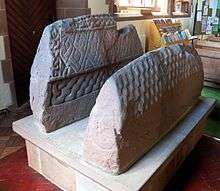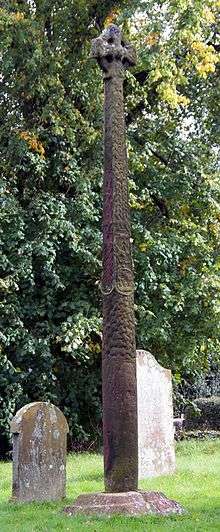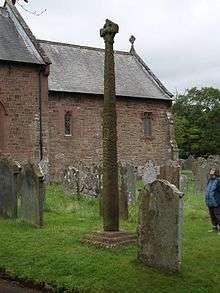St Mary's Church, Gosforth
| St Mary's Church, Gosforth | |
|---|---|
 West end of St Mary's Church, Gosforth | |
 St Mary's Church, Gosforth Location in Cumbria | |
| 54°25′09″N 3°25′53″W / 54.4192°N 3.4314°WCoordinates: 54°25′09″N 3°25′53″W / 54.4192°N 3.4314°W | |
| OS grid reference | NY 072 036 |
| Location | Gosforth, Cumbria |
| Country | England |
| Denomination | Anglican |
| Website |
achurchnearyou |
| Architecture | |
| Status | Parish church |
| Functional status | Active |
| Heritage designation | Grade I |
| Designated | 9 March 1967 |
| Architect(s) | C. J. Ferguson |
| Architectural type | Church |
| Style | Norman, Gothic Revival |
| Completed | 1899 |
| Specifications | |
| Materials | Stone, slate roofs |
| Administration | |
| Parish | Gosforth |
| Deanery | Calder |
| Archdeaconry | West Cumberland |
| Diocese | Carlisle |
| Province | York |
| Clergy | |
| Priest(s) | Revd John Riley |
St Mary's Church in the village of Gosforth, Cumbria, England, is an active Anglican parish church in the deanery of Calder, the archdeaconry of West Cumberland, and the diocese of Carlisle. Its benefice is united with those of St Olaf, Wasdale Head, and St Michael, Nether Wasdale.[1] The church is recorded in the National Heritage List for England as a designated Grade I listed building.[2] It is associated with "a unique Viking-age assemblage" of carved stones.[3]
History
This has been a Christian site since the 8th century. The oldest fabric in the present church dates from the 12th century.[2] The church was reconstructed in 1789, but most of the fabric currently present is the result of a virtual rebuilding by C. J. Ferguson between 1896 and 1899.[3]
Architecture
St Mary's is constructed in stone with a slate roof. Its plan consists of a nave, a north aisle, a south porch, a chancel and north vestries.[2] The 19th-century rebuilding is in Decorated style.[3] At the west end is a corbelled-out bellcote. The gabled porch leads to the south door, to the right of which is a blocked Norman doorway, formerly on the north side of the church. There is a monument dated 1834 on the exterior of the north wall of the chancel.[2][3]
Inside the church is a four-bay north arcade, consisting of pointed arches carried on columns with octagonal capitals.[2] The 14th-century chancel arch is set on richly carved Norman capitals.[3]
In a niche at the east end of the aisle are two carved Viking hogback stones. These are very rare pre-Norman tomb markers that were found under the foundations of a 12th-century wall of the church during restoration in 1896-97. The early 11th century is the latest possible date.[4] The hogbacks are each in the shape of a house. The larger tomb has on its sides humans astride smaller serpents battling with larger serpents. The smaller stone has two armies thought to be concluding a truce.
In and around the niche, and in the porch are other fragments of medieval stones. The small octagonal font dates from the 19th century.[2] Also in the church is a Chinese bell dating from 1839, which was captured from the Anunghoy Fort in the Battle of the Bogue (1841) on the Canton River. It was donated to the church in 1844.[3]
One of the stone slabs is the so-called "Gosforth fishing stone" and is presumably the same artist who carved the cross, outside. It represents Thor and the giant Hymir, fishing for Jörmungandr, the serpent which encircles the world.[5] It is possibly a remnant of another cross.[6]
The stained glass dates mainly from the late 19th century, most of which is by Ward and Hughes.[3] The two-manual pipe organ was made by Conacher and Company of Huddersfield, and rebuilt and expanded in 1984 by Sixsmith.[7]
External features
The most important feature in the churchyard is a Viking stone cross dating from the early part of the 10th century.[3] It is a sandstone structure standing 4.42 metres (14.5 ft) high, and is elaborately carved with human figures and beasts, mainly depicting scenes from Scandinavian mythology. This is the tallest Viking cross in the country. It is designated as a scheduled monument.[8] Another cross of similar age has been cut down to form a sundial.[3]
In the northeast corner of the churchyard is a hut or shed that has been constructed from left-over stones, including 13th-century grave-covers, pieces of stone carved with zigzags, and a corbel. The structure is listed at Grade II.[9] Also in the churchyard are three tombstones bearing dates between 1711 and 1729, each of which has been listed at Grade II.[10][11][12]
Gallery
 Interior view of St Mary's church, Gosforth, Cumbria.
Interior view of St Mary's church, Gosforth, Cumbria. hogback tombs in the church
hogback tombs in the church Gosforth cross from the NW
Gosforth cross from the NW- Norman capital with three faces
 the "fishing stone" in the church; possibly remnant of a second cross, showing Thor fishing.
the "fishing stone" in the church; possibly remnant of a second cross, showing Thor fishing.- Tombs in the porch
- View of the Viking Cross and church, from the SW
- The stump of the second cross
 Memorial to Humphrey Senhouse, Gosforth, Cumbria
Memorial to Humphrey Senhouse, Gosforth, Cumbria The grave of local antiquarian and historian, Charles Arundel Parker.
The grave of local antiquarian and historian, Charles Arundel Parker.
See also
- Grade I listed churches in Cumbria
- Grade I listed buildings in Cumbria
- Listed buildings in Gosforth, Cumbria
References
- ↑ St Mary, Gosforth, Church of England, retrieved 17 July 2012
- 1 2 3 4 5 6 Historic England, "Church of St Mary, Gosforth (1063710)", National Heritage List for England, retrieved 17 July 2012
- 1 2 3 4 5 6 7 8 9 Hyde, Matthew; Pevsner, Nikolaus (2010) [1967], Cumbria, The Buildings of England, New Haven and London: Yale University Press, pp. 367–369, ISBN 978-0-300-12663-1
- ↑ C A Parker, The Gosforth District, 1904
- ↑ Rollason, David W. (2003). Northumbria, 500-1100: Creation and Destruction of a Kingdom. Cambridge UP. pp. 254–. ISBN 9780521813358. Retrieved 14 August 2013.
- ↑ Calverley, William Slater (1899). Notes on the Early Sculptured Crosses, Shrines and Monuments in the Present Diocese of Carlisle. T. Wilson. p. 171. Retrieved 14 August 2013.
- ↑ Cumberland (Cumbria), Gosforth, St. Mary, Wasdale Road (N03581), British Institute of Organ Studies, retrieved 17 July 2012
- ↑ Historic England, "High cross in St Mary's churchyard, Gosforth (1012643)", National Heritage List for England, retrieved 17 July 2012
- ↑ Historic England, "Toolshed in northeast corner of St Mary's churchyard, Gosforth (1086663)", National Heritage List for England, retrieved 17 July 2012
- ↑ Historic England, "Ann Southward's tombstone circa 20 feet to southeast of Cross in St Mary's churchyard, Gosforth (1065691)", National Heritage List for England, retrieved 17 July 2012
- ↑ Historic England, "William Dixon's tombstone circa 13 feet to east of Cross in St Mary's churchyard, Gosforth (1065692)", National Heritage List for England, retrieved 17 July 2012
- ↑ Historic England, "Thomas Dixon's tombstone circa 3 feet to east of Cross in St Mary's churchyard, Gosforth (1086664)", National Heritage List for England, retrieved 17 July 2012
External links
| Wikimedia Commons has media related to St Mary's church, Gosforth, Cumbria. |
